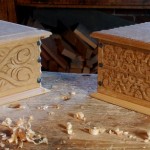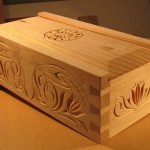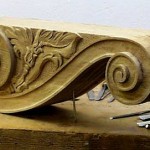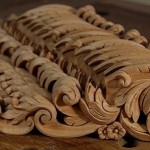Woodworking is full of variety, as I mentioned a few days ago. It is also full of “slippery slopes.” A lot of us slid down the Neanderthal slope (handtool users) and sold off our tailed tools. Kari Hultman welcomed me to another slope, the woodcarving slope with that “fun slippery slope” phrase.
If you think woodworking has many different avenues, just wait until you turn off onto the long and winding road named woodcarving. Woodcarving has countless offshoots, sidestreets and byways.
I thought about doing a brief survey of the variety of woodcarving forms. Bzzzt! One can’t do a brief survey. There are too many choices. So, I’ll just mention a few of my favorites, a few (only a few) of the impressive woodcarving woodworkers I’ve “met” on the wondrous woodworking world wide web.
Let’s start in 2 dimensions.
Have you ever visited Plimoth Plantation? It is very well worth the time to learn more about some of the country’s early settlers, why they came here, how they lived, and of course how they celebrated the first Thanksgiving.

While working at Plimoth, Peter Follansbee has become an indispensable expert on 17th century New England furniture. He researches and practices furniture making as done by the early settlers. That particular style of woodcarving is very distinctive. These little boxes are small samples of the kind of work applied to furniture panels, chairs, doors, and almost any flat surface that could benefit from adornment. One of the fascinating aspects of the work is that many of the shapes are layed out and executed directly from the tools. One can clearly see how chisels of different sweeps and sizes were used to form many of the curves and swirls. Peter not only works at the Plantation, but teaches classes, publishes a blog of his “joiners notes,” and has recently issued a new DVD “17th Century New England Carving” that is already getting great reviews. To gain a better perspective on this form of carving see one of Peter’s most recent blog entries which shows many examples of this work. Examine the photos very carefully, especially the last one where the tool marks are obvious. You will end up wondering how many chisels Peter must have.

Staying in two dimensions, and showing another decorated box, we turn to a different sort of carving. Chip carving is done with knives, usually only two. Wayne Barton tells us it is derived from a Swiss style of woodworking, and we most often see it executed as beautiful decorations using heavily repeated patterns. While I’ve seen this form over the years, it was Kari Hultman, The Village Carpenter, who wrote about the technique some time ago. Being a design oriented person, she uses chip carving not as an end to itself, but as a method of adorning other things she creates. The box illustrated at the left uses a traditional geometric pattern on the top and wonderful flowering panels (perhaps Pennsylvania Dutch?) on the other surfaces. For more delight, see what she did to her coffin smoother plane. We can also see that lettercarving is a near cousin of chip carving. Oh, so many beautiful things, such a slippery slope, and so little time.
Before we jump to 3 dimensional objects, let’s look at a couple of architectural carvings.


This is a category built upon classic motifs and patterns. We’ve all seen them frequently. Many today are machine made, but the hand carved versions are breathtaking in comparison. Again, these are only a small sample of of the category that includes everything from shell panel decorations, egg and dart mouldings, flame finials, ball and claw feet, and all sorts of things too numerous to mention. Chris Pye’s exquisite acanthus spirals (left) will decorate the ends of stair steps. (Rotate them 180 in your mind.) Imagine knocking out an order for 15 of those this week. Or, maybe making a couple of corbels (right) to hold the roof over the back door. Chris Pye is a British woodcarver whose scope covers a broad range of carving categories. He teaches classes, (recently in the U.S.), publishes books and DVDs, and maintains a web site where he offers “Slipstones” which are e-books about woodcarving techniques. You might want to subscribe to his newsletter to learn about where and what Chris will be teaching next.
We’re still not at 3 dimensions yet. Next time…
Oh yeah, that beautiful home at the end of the long and winding road. That’s not mine!
Thank you for the nice write-up, Bob, and welcome to the wonderful world of woodcarving! I wasn’t aware of Chris’ site and newsletter. Going to check them out right now….
If you look more carefully at Peter’s blog (and a little further back) you will see that he uses and recommends very few chisels. And he will show you when you talk to him at Plimoth.
Sure rfrancis. I know that.
Peter wrote about the set of chisels needed for his work maybe a year ago. But, that spoils things for those of us who “need” one of every sweep in one of every size. 🙂